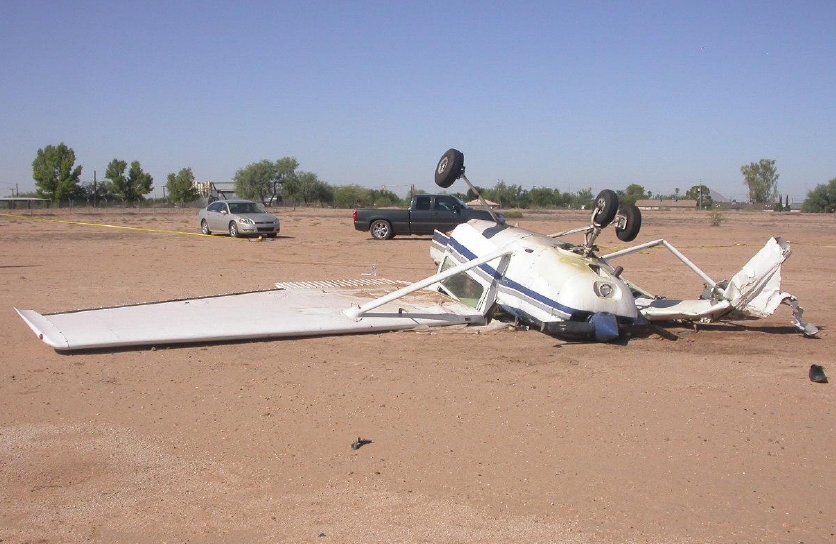
ASN Wikibase Occurrence # 68177
This information is added by users of ASN. Neither ASN nor the Flight Safety Foundation are responsible for the completeness or correctness of this information.
If you feel this information is incomplete or incorrect, you can submit corrected information.
| Date: | Wednesday 9 September 2009 |
| Time: | 09:45 |
| Type: |  Cessna 152 |
| Owner/operator: | Air Safety Flight Academy |
| Registration: | N94741 |
| MSN: | 15285778 |
| Year of manufacture: | 1983 |
| Total airframe hrs: | 16444 hours |
| Fatalities: | Fatalities: 1 / Occupants: 2 |
| Aircraft damage: | Substantial |
| Category: | Accident |
| Location: | Coolidge, AZ -
 United States of America United States of America
|
| Phase: | En route |
| Nature: | Training |
| Departure airport: | Coolidge, AZ (P08) |
| Glendale, AZ (KGEU) | |
| Investigating agency: | NTSB |
| Confidence Rating: |
On September 9, 2009, about 0945 mountain standard time, a Cessna 152, N94741, and a Piper PA-28-161, N994T, collided about 4,500 feet mean sea level (MSL) while located about one-half mile east of Coolidge, Arizona. Neither the flight instructor nor his dual student in the PA-28-161 were injured, but one of the private pilots in the Cessna 152 received serious injuries, and the second private pilot in the Cessna 152 was killed during the accident sequence.
Both airplanes involved in the mid-air collision were on simulated instrument meteorological conditions training flights in visual flight rules conditions. Both lesson profiles called for the pilot in the left-seat to wear a vision-restricting instrument training hood, while the pilot in the right seat acted as a safety/lookout pilot. The airplanes were being operated in an area of high density student training. The left seat pilot of the Piper had just rolled out of a right turn associated with the entry to a practice holding pattern to a non-controlled airport. The left-seat pilot of the Cessna had departed a non-controlled airport and was in an en route climb to the cruise altitude, at which he would return to his home airport. Neither airplane was receiving radar traffic advisories, nor was either in contact with a controlling Federal Aviation Administration (FAA) facility. The pilots in the Piper said that they were monitoring the designated practice area frequency, and had heard no other airplanes in the immediate area. The survivor in the Cessna could not clearly remember if he had been making position calls on the practice area frequency, but his radio was found set to that frequency and he said that he had been trained to make such calls. The Cessna was on a magnetic ground track of about 265 degrees, and the Piper had rolled out on a course intercept heading of 288 degrees about 10 to 15 seconds prior to the collision. The collision took place at 4,500 feet. During the collision sequence, the Cessna's right wing penetrated the lower left engine cowl of the Piper, and the Piper's left main landing gear wheel and tire impacted the right side of the Cessna's aft fuselage. After the impact, during which a portion of the Cessna's right wing and tail section separated, the Cessna entered an uncontrolled descent into the terrain and the pilots in the Piper executed a power-off forced landing. The weather at the time was reported as clear skies with 10 miles visibility. Neither safety/lookout pilot saw the other airplane prior to the collision.
Probable Cause: The failure of both safety/spotter pilots to see and avoid the other airplane.
Sources:
NTSB
Location
Images:

Photo: NTSB
Revision history:
| Date/time | Contributor | Updates |
|---|---|---|
| 09-Sep-2009 11:17 | harro | Added |
| 09-Sep-2009 13:33 | RobertMB | Updated |
| 09-Sep-2009 14:45 | angels one five | Updated |
| 17-Mar-2010 12:15 | harro | Updated [Time, Operator, Other fatalities, Phase, Nature, Departure airport, Source] |
| 21-Dec-2016 19:25 | ASN Update Bot | Updated [Time, Damage, Category, Investigating agency] |
| 02-Dec-2017 16:15 | ASN Update Bot | Updated [Operator, Other fatalities, Departure airport, Destination airport, Source, Narrative] |
Corrections or additions? ... Edit this accident description
The Aviation Safety Network is an exclusive service provided by:


 ©2024 Flight Safety Foundation
©2024 Flight Safety Foundation